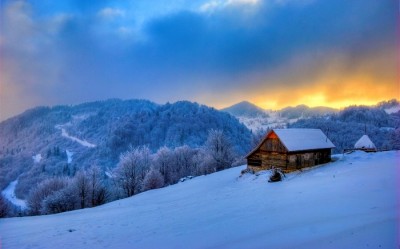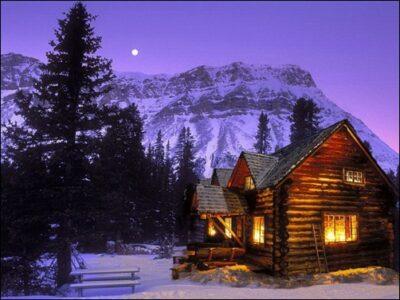When the dead of winter starts setting in, the ability to maintain heat between your home or cabin walls can become a bit of a challenge. Sub-freezing and negative temperatures seem to draw the warmth out of your home at such a rapid pace that battling it becomes difficult.
Making sure that your house is prepared before winter hits is a great way to get a head start on winter, but often times it can be hard to recognize drafty and compromised areas before it is too late. Fortunately, once you know what to look for, most of the problems can be dealt with in relatively easy and cost effective ways – right in the middle of frigid temps. It’s never too late to start winterizing your cabin, so here are some of the main causes of heat and energy loss that everyone should monitor.
1. Windows
A lot of heat and energy can be lost through drafty windows, so making sure that they are sealed up tight is a major step to winterizing your cabin. If a quick fix is your goal, the easiest way to block drafts is to strip pre-existing caulk and refinish the seals around each window. Once dry, head to your local hardware store and purchase heat-shrinking plastic wrap with double-sided tape to cover openings and act as a barrier between the window and your room. Take advantage of sunlight that naturally heats your home during the day, but before you go to bed, make sure to close all blinds and drapes to keep frigid temperatures from permeating through window panes.
Since many older homes have single pane windows or windows that are not Energy Star rated, you can also replace the windows in your home or purchase storm windows to add an extra barrier. If you plan on purchasing new windows, make sure they have a low E coating designed for use in northern states. The coating acts as a double-sided reflective barrier, reflecting sun and warmth in during the day and keeping the cold out during winter months. As a cheaper and less time-consuming method, do some research into proper storm windows. They are typically compression fit to eliminate drafts and will not block your existing windows from sight.
2. Doors
While there isn’t much that can be done about opening and closing doors in the winter, you can check that seals are as tight as possible and that there is an adequate amount of calking around the frame and jamb of the entryway. Two simple methods of narrowing down high-draft areas is either to take a lighter around cracks of the closed door and see if the flame flickers intensely, or check from outside at night to see if you notice any light coming through. These gaps will be the biggest problem areas and require immediate attention.
Adding weatherstripping is a good way to seal those leaks, but if you need to seal in a hurry, try using a staple gun to secure pieces of cloth, such as an old rug or drapes you no longer use, along the edges where gaps are most prominent. Proper tubing can be purchased at your local hardware store and is quick and easy to install. Once the door is closed for the evening, place draft snakes at the bottom to provide an extra barrier. These can be purchased in stores or made of rolled blankets, old tube socks or neckties that are filled with sand or cat litter to add weight.
3. Plumbing
Make sure that all exposed pipes leading into your home are wrapped with heat tape and an insulating foam to keep them from freezing. Also, check to make sure that any holes surrounding the pipes as they enter your home are securely sealed using foam spray. Not only will this keep the heat in, it will help to keep any unwanted pests from being able to gain entry. On nights that the temperature is supposed to dip below freezing, always make sure to leave faucets dripping, both inside and out, to keep pipes from bursting. If you have a septic tank to consider, try placing hay bales over the area where your tank is kept to avoid any unwanted freeze and overflow.
4. Attic & Basement
Since heat rises, one of the best places to check for winterizing your cabin is in the attic. Squirrels and other pests love to chew through and make homes out of your insulation throughout the year, so make sure to check that insulation is intact and cover all the necessary areas. Next, go around and try to find any seals that may have been compromised, such as chimney bypasses, vents and HVAC ducts, and seal any leaky spots with spray foam, caulk or insulation. Once you have secured the attic, always make sure to check the basement for any draft leakage that could pour in cold air, and seal areas around electrical and furnace openings that lead into your home.
5. Flooring
Regardless of whether your home has wood floors or carpet, if temperatures reach below freezing, chances are you can start to feel the difference when walking through your home. The best way to keep the cold from radiating through the floorboards is to purchase a number of thick rugs and spread them evenly throughout the house. They will soak up the warm air from above and help trap the cold air below, allowing a more even temperature from floor to ceiling. And if you really want a project, try taking a look at radiant heating. The idea dates back thousands of years, but more recently the process uses electric or hydronic heating pipes inlayed underneath the floor, projecting heat upward and outward from the coils for a whole home heating system.
Other Common Leak Areas
Additionally, always make sure to check for gaps around recessed lighting fixtures and unfinished walls behind cabinets and closets. As a general rule, when you notice icicles forming on the side of your home near an area that should be sealed from the inside, this is a good place to start looking for broken seals and leaks along your roof and from inside your home. Also, when the fireplace or wood stove isn’t being used, always make sure the flue is closed to keep unwanted winds and drafts from flooding inside.
According to the U.S. Department of Energy [5], properly sealing and insulating your home can reduce heat and energy losses by anywhere from 5 to 30 percent in the winter. And if you utilize a wood stove throughout winter, you already know firewood is a precious commodity that can’t afford to be wasted. By taking a few days to thoroughly check your home for drafts and leaks, you can drastically reduce heat loss and keep your cabin nice and toasty for those long winter nights.
What are other ways you winter proof your home or cabin? Share your tips in the section below:
Get $600 Worth Of Survival Blueprints … Absolutely Free! [6]


